Seasonal Variations of Dissolved Organic Matter by Fluorescent Analysis in a Typical River Catchment in Northern China
Abstract
:1. Introduction
2. Materials and Methods
2.1. Study Area
2.2. Field Sampling and Water Quality Determination
2.3. Optical Analysis
2.4. Land Use Classification and Statistical Analysis
3. Results
3.1. Variation in Water Quality Parameters
3.2. Component Identification by PARAFAC Modelling
3.3. Content and Properties of DOM
3.4. Land-Use Change in Three Seasons
4. Discussion
4.1. Characterization of DOM and Spatio-Temporal Variations
4.2. Effect of Land Use on DOM in the Subcatchments
4.3. Effects of Rainfall on Organic Matter Characteristics under Different Land-Use Types
5. Conclusions
Author Contributions
Funding
Institutional Review Board Statement
Informed Consent Statement
Data Availability Statement
Acknowledgments
Conflicts of Interest
References
- Wang, M.; Chen, Y. Generation and characterization of DOM in wastewater treatment processes. Chemosphere 2018, 201, 96–109. [Google Scholar] [CrossRef]
- Singh, S.; D′Sa, E.J.; Swenson, E.M. Chromophoric dissolved organic matter (CDOM) variability in Barataria Basin using excitation-emission matrix (EEM) fluorescence and parallel factor analysis (PARAFAC). Sci. Total Environ. 2010, 408, 3211–3222. [Google Scholar] [CrossRef] [PubMed]
- Lambert, T.; Bouillon, S.; Darchambeau, F.; Morana, C.; Roland, F.A.E.; Descy, J.-P.; Borges, A.V. Effects of human land use on the terrestrial and aquatic sources of fluvial organic matter in a temperate river basin (The Meuse River, Belgium). Biogeochemistry 2017, 136, 191–211. [Google Scholar] [CrossRef] [Green Version]
- Persson, T.; Wedborg, M. Multivariate evaluation of the fluorescence of aquatic organic matter. Anal. Chim. Acta 2001, 434, 179–192. [Google Scholar] [CrossRef]
- Huguet, A.; Vacher, L.; Relexans, S.; Saubusse, S.; Froidefond, J.-M.; Parlanti, E. Properties of fluorescent dissolved organic matter in the Gironde Estuary. Org. Geochem. 2009, 40, 706–719. [Google Scholar] [CrossRef]
- Mostofa, K.M.G.; Yuan, J.; Sakugawa, H.; Liu, C.-Q. Equal treatment of different EEM data on parafac modeling produces artifact fluorescent components that have misleading biogeochemical consequences. Environ. Sci. Technol. 2019, 53, 561–563. [Google Scholar] [CrossRef] [Green Version]
- Shao, T.; Wang, T. Effects of land use on the characteristics and composition of fluvial chromophoric dissolved organic matter (CDOM) in the Yiluo River watershed, China. Ecol. Indic. 2020, 114, 106332. [Google Scholar] [CrossRef]
- Evans, C.D.; Freeman, C.; Monteith, D.T.; Reynolds, B.; Fenner, N. Climate change (Communication arising): Terrestrial export of organic carbon. Nature 2002, 415, 862–863. [Google Scholar] [CrossRef]
- Shin, Y.; Lee, E.-J.; Jeon, Y.-J.; Hur, J.; Oh, N.-H. Hydrological changes of DOM composition and biodegradability of rivers in temperate monsoon climates. J. Hydrol. 2016, 540, 538–548. [Google Scholar] [CrossRef]
- Mattsson, T.; Kortelainen, P.; Räike, A. Export of DOM from boreal catchments impacts of land use cover and climate. Biogeochemistry 2005, 76, 373–394. [Google Scholar] [CrossRef]
- Stockwell, J.D.; Doubek, J.P.; Adrian, R.; Anneville, O.; Carey, C.C.; Carvalho, L.; De Senerpont Domis, L.N.; Dur, G.; Frassl, M.A.; Grossart, H.-P.; et al. Storm impacts on phytoplankton community dynamics in lakes. Glob. Chang. Biol. 2020, 26, 2756–2784. [Google Scholar] [CrossRef] [PubMed] [Green Version]
- Fellman, J.B.; D′Amore, D.V.; Hood, E.; Boone, R.D. Fluorescence characteristics and biodegradability of dissolved organic matter in forest and wetland soils from coastal temperate watersheds in southeast Alaska. Biogeochemistry 2008, 88, 169–184. [Google Scholar] [CrossRef]
- Wilson, H.F.; Xenopoulos, M.A. Effects of agricultural land use on the composition of fluvial dissolved organic matter. Nat. Geosci. 2009, 2, 37–41. [Google Scholar] [CrossRef]
- Zhao, Q.; Liu, S.; Deng, L.; Dong, S.; Yang, Z.; Liu, Q. Determining the influencing distance of dam construction and reservoir impoundment on land use: A case study of Manwan Dam, Lancang River. Ecol. Eng. 2013, 53, 235–242. [Google Scholar] [CrossRef]
- Singh, S.; Inamdar, S.; Mitchell, M.; McHale, P. Seasonal pattern of dissolved organic matter (DOM) in watershed sources: Influence of hydrologic flow paths and autumn leaf fall. Biogeochemistry 2014, 118, 321–337. [Google Scholar] [CrossRef]
- Chen, Y.; Song, Q.; Pan, L.; Jia, M.; Li, C.; Hu, B.; Wu, G. Trace metals, organic carbon and nutrients in the Beidagang Wetland Nature Reserve, northern China. PLoS ONE 2018, 13, e0204812. [Google Scholar] [CrossRef] [PubMed] [Green Version]
- Liang, X.Q.; Sun, X.W.; Huang, T.S.; Huang, H.; Zhang, H.Y. Spatial distribution characteristics of total nitrogen, total phosphorus and organic matter in surface sediments of Duliujianhe River. IOP Conf. Ser. Mater. Sci. Eng. 2018, 392, 042044. [Google Scholar] [CrossRef]
- Rochelle-Newall, E.J.; Fisher, T.R. Chromophoric dissolved organic matter and dissolved organic carbon in Chesapeake Bay. Mar. Chem. 2002, 77, 23–41. [Google Scholar] [CrossRef]
- Dilling, J.; Kaiser, K. Estimation of the hydrophobic fraction of dissolved organic matter in water samples using UV photometry. Water. Res. 2002, 36, 5037–5044. [Google Scholar] [CrossRef]
- Barreto, S.R.G.; Nozaki, J.; Barreto, W.J. Origin of Dissolved Organic Carbon Studied by UV-vis Spectroscopy. Acta Hydrochim. Hydrobiol. 2003, 31, 513–518. [Google Scholar] [CrossRef]
- Helms, J.R.; Stubbins, A.; Ritchie, J.D.; Minor, E.C.; Kieber, D.J.; Mopper, K. Absorption spectral slopes and slope ratios as indicators of molecular weight, source, and photobleaching of chromophoric dissolved organic matter. Limnol. Oceanogr. 2008, 53, 955–969. [Google Scholar] [CrossRef] [Green Version]
- Weishaar, J.L.; Aiken, G.R.; Bergamaschi, B.A.; Fram, M.S.; Fujii, R.; Mopper, K. Evaluation of specific ultraviolet absorbance as an indicator of the chemical composition and reactivity of dissolved organic carbon. Environ. Sci. Technol. 2003, 37, 4702–4708. [Google Scholar] [CrossRef] [PubMed]
- Murphy, K.R.; Butler, K.D.; Spencer, R.G.; Stedmon, C.A.; Boehme, J.R.; Aiken, G.R. Measurement of dissolved organic matter fluorescence in aquatic environments: An interlaboratory comparison. Environ. Sci. Technol. 2010, 44, 9405–9412. [Google Scholar] [CrossRef] [PubMed]
- Zsolnay, A.; Baigar, E.; Jimenez, M.; Steinweg, B.; Saccomandi, F. Differentiating with fluorescence spectroscopy the sources of dissolved organic matter in soils subjected to drying. Chemosphere 1999, 38, 45–50. [Google Scholar] [CrossRef]
- Tedetti, M.; Cuet, P.; Guigue, C.; Goutx, M. Characterization of dissolved organic matter in a coral reef ecosystem subjected to anthropogenic pressures (La Réunion Island, Indian Ocean) using multi-dimensional fluorescence spectroscopy. Sci. Total Environ. 2011, 409, 2198–2210. [Google Scholar] [CrossRef]
- Ishii, S.K.; Boyer, T.H. Behavior of reoccurring PARAFAC components in fluorescent dissolved organic matter in natural and engineered systems: A critical review. Environ. Sci. Technol. 2012, 46, 2006–2017. [Google Scholar] [CrossRef]
- Mostofa, K.M.G.; Yoshioka, T.; Mottaleb, A.; Vione, D. Photobiogeochemistry of Organic Matter; Springer: Berlin/Heidelberg, Germany, 2013. [Google Scholar]
- Ni, B.-J.; Fang, F.; Xie, W.-M.; Sun, M.; Sheng, G.-P.; Li, W.-H.; Yu, H.-Q. Characterization of extracellular polymeric substances produced by mixed microorganisms in activated sludge with gel-permeating chromatography, excitation–emission matrix fluorescence spectroscopy measurement and kinetic modeling. Water Res. 2009, 43, 1350–1358. [Google Scholar] [CrossRef] [PubMed]
- Romera-Castillo, C.; Sarmento, H.; Alvarez-Salgado, X.A.; Gasol, J.M.; Marrasé, C. Net production and consumption of fluorescent colored dissolved organic matter by natural bacterial assemblages growing on marine phytoplankton exudates. Appl. Environ. Microbiol. 2011, 77, 7490–7498. [Google Scholar] [CrossRef] [Green Version]
- Mostofa, K.M.G.; Li, W.; Wu, F.C.; Liu, C.Q.; Liao, H.; Zeng, L.; Xiao, M. Environmental characteristics and microbial changes of sediment pore water dissolved organic matter in four Chinese. Environ. Sci. Pollut. Res. 2018, 25, 2783–2804. [Google Scholar] [CrossRef]
- Zhang, Y.; Liu, X.; Wang, M.; Qin, B. Compositional differences of chromophoric dissolved organic matter derived from phytoplankton and macrophytes. Org. Geochem. 2013, 55, 26–37. [Google Scholar] [CrossRef]
- McKnight, D.M.; Boyer, E.W.; Westerhoff, P.K.; Doran, P.T.; Kulbe, T.; Andersen, D.T. Spectrofluorometric characterization of dissolved organic matter for indication of precursor organic material and aromaticity. Limnol. Oceanogr. 2001, 46, 38–48. [Google Scholar] [CrossRef]
- Ran, L.; Lu, X.X.; Sun, H.; Han, J.; Li, R.; Zhang, J. Spatial and seasonal variability of organic carbon transport in the Yellow River, China. J. Hydrol. 2013, 498, 76–88. [Google Scholar] [CrossRef]
- Xiao, M.; Wu, F.C.; Yi, Y.B.; Han, Z.; Wang, Z. Optical Properties of Dissolved Organic Matter and Controlling Factors in Dianchi Lake Waters. Water 2019, 11, 1967. [Google Scholar] [CrossRef] [Green Version]
- Zhao, Y.; Song, K.; Lv, L.; Wen, Z.; Du, J.; Shang, Y. Relationship changes between CDOM and DOC in the Songhua River affected by highly polluted tributary, Northeast China. Environ. Sci. Pollut. Res. 2018, 25, 25371–25382. [Google Scholar] [CrossRef]
- Zhou, Y.; Zhang, Y.; Shi, K.; Liu, X.; Niu, C. Dynamics of chromophoric dissolved organic matter influenced by hydrological conditions in a large, shallow, and eutrophic lake in China. Environ. Sci. Pollut. Res. 2015, 22, 12992–13003. [Google Scholar] [CrossRef] [PubMed]
- Maie, N.; Scully, N.M.; Pisani, O.; Jaffé, R. Composition of a protein-like fluorophore of dissolved organic matter in coastal wetland and estuarine ecosystems. Water Res. 2007, 41, 563–570. [Google Scholar] [CrossRef] [PubMed]
- McIntyre, A.M.; Guéguen, C. Binding interactions of algal-derived dissolved organic matter with metal ions. Chemosphere 2013, 90, 620–626. [Google Scholar] [CrossRef]
- Yu, H.; Song, Y.; Tu, X.; Du, E.; Liu, R.; Peng, J. Assessing removal efficiency of dissolved organic matter in wastewater treatment using fluorescence excitation emission matrices with parallel factor analysis and second derivative synchronous fluorescence. Bioresour. Technol. 2013, 144, 595–601. [Google Scholar] [CrossRef]
- Wang, J.; Li, H.; Chen, Y.; Fang, Y.; Wang, Z.; Tao, T.; Zuo, Y. Comparative characterisation of two fulvic acids from East Lake and Liangzi Lake in central China. Environ. Chem. 2015, 12, 189–197. [Google Scholar] [CrossRef]
- Du, X.; Xu, Z.; Li, J.; Zheng, L. Characterization and removal of dissolved organic matter in a vertical flow constructed wetland. Ecol. Eng. 2014, 73, 610–615. [Google Scholar] [CrossRef]
- Correll, D.L.; Jordan, T.E.; Weller, D.E. Effects of precipitation, air temperature, and land use on organic carbon discharges from Rhode River watersheds. Water. Air. Soil. Pollut. 2001, 128, 139–159. [Google Scholar] [CrossRef]
- Yang, X.M.; Yuan, J.; Yue, F.J.; Li, S.L.; Wang, B.L.; Mohinuzzaman, M.; Liu, Y.J.; Senesi, N.; Lao, X.Y.; Li, L.L. New insights into mechanisms of sunlight- and dark-mediated high-temperature accelerated diurnal production-degradation of fluorescent DOM in lake waters. Sci. Total Environ. 2021, 760, 143377. [Google Scholar] [CrossRef] [PubMed]
- Zhou, Y.; Zhou, L.; He, X.; Jang, K.-S.; Yao, X.; Hu, Y.; Zhang, Y.; Li, X.; Spencer, R.G.; Brookes, J.D. Variability in dissolved organic matter composition and biolability across gradients of glacial coverage and distance from glacial terminus on the Tibetan Plateau. Environ. Sci. Technol. 2019, 53, 12207–12217. [Google Scholar] [CrossRef]
- Fellman, J.; Hood, E.; Edwards, R.; D′Amore, D. Changes in the concentration, biodegradability, and fluorescent properties of dissolved organic matter during stormflows in coastal temperate watersheds. J. Geophys. Res. 2009, 114, 114. [Google Scholar] [CrossRef]
- Zeng, S.; Dong, X.; Chen, J. Toxicity assessment of metals in sediment from the lower reaches of the Haihe River Basin in China. Int. J. Sediment Res. 2013, 28, 172–181. [Google Scholar] [CrossRef]
- Vignati, D.A.L.; Dominik, J.; Beye, M.L.; Pettine, M.; Ferrari, B.J.D. Chromium(VI) is more toxic than chromium(III) to freshwater algae: A paradigm to revise? Ecotoxicol. Environ. Saf. 2010, 73, 743–749. [Google Scholar] [CrossRef] [PubMed]
- Shi, Y.; Zhang, L.; Li, Y.; Zhou, L.; Zhou, Y.; Zhang, Y.; Huang, C.; Li, H.; Zhu, G. Influence of land use and rainfall on the optical properties of dissolved organic matter in a key drinking water reservoir in China. Sci. Total Environ. 2020, 699, 134301. [Google Scholar] [CrossRef] [PubMed]
- Endreny, T.A. Land Use and Land Cover Effects on Runoff Processes: Urban and Suburban Development. In Encyclopedia of Hydrological Sciences; Anderson, M.G., McDonnell, J.J., Eds.; John Wiley & Sons, Ltd.: Chichester, UK, 2005; p. 122. [Google Scholar]
- Van Stan, J.T.; Stubbins, A. Tree-DOM: Dissolved organic matter in throughfall and stemflow. Limnol. Oceanogr. Lett. 2018, 3, 199–214. [Google Scholar] [CrossRef]
- Li, B.; Xiao, W.; Wang, Y.; Yang, M.; Huang, Y. Impact of land use/cover change on the relationship between precipitation and runoff in typical area. J. Water. Clim. Chang. 2018, 9, 261–274. [Google Scholar] [CrossRef]
- Lee, G.F.; Jones-Lee, A. Assessing the Water Quality Impacts of Phosphorus in Runoff from Agricultural Lands. In Environmental Impact of Fertilizer on Soil and Water, ACS Symposium Series; American Chemical Society: Washington, DC, USA, 2003; pp. 207–219. [Google Scholar]
- Dalmagro, H.J.; Johnson, M.S.; de Musis, C.R.; Lathuillière, M.J.; Graesser, J.; Pinto-Júnior, O.B.; Couto, G. Spatial patterns of DOC concentration and DOM optical properties in a Brazilian tropical river-wetland system. J. Geophys. Res. Biogeosci. 2017, 122, 1883–1902. [Google Scholar] [CrossRef]
- Hansen, V.D.; Nestlerode, J.A. Carbon sequestration in wetland soils of the northern Gulf of Mexico coastal region. Wetl. Ecol. Manag. 2014, 22, 289–303. [Google Scholar] [CrossRef]
- Winter, T.C. Relation of streams, lakes, and wetlands to groundwater flow systems. Hydrogeol. J. 1999, 7, 28–45. [Google Scholar] [CrossRef]
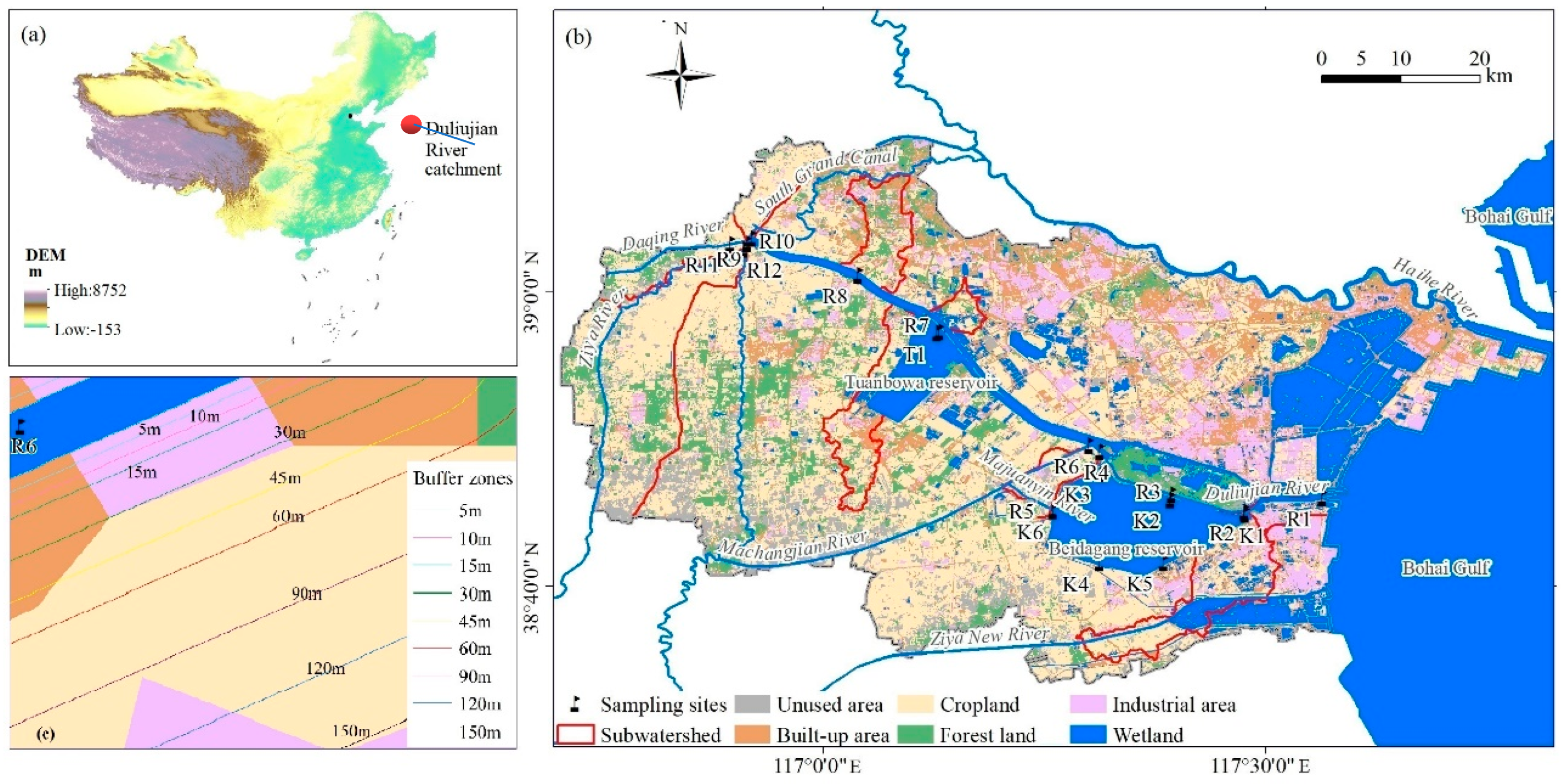
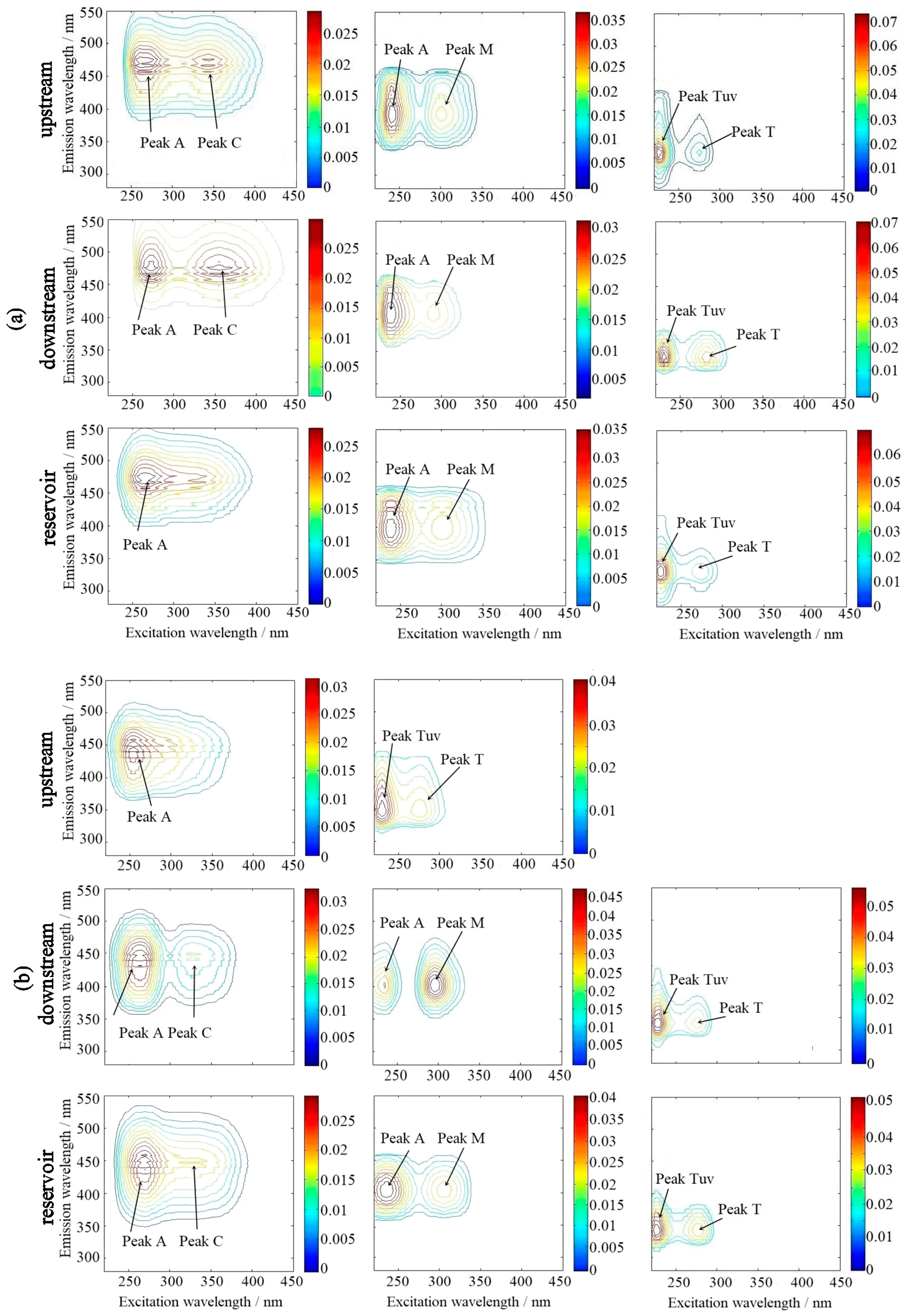
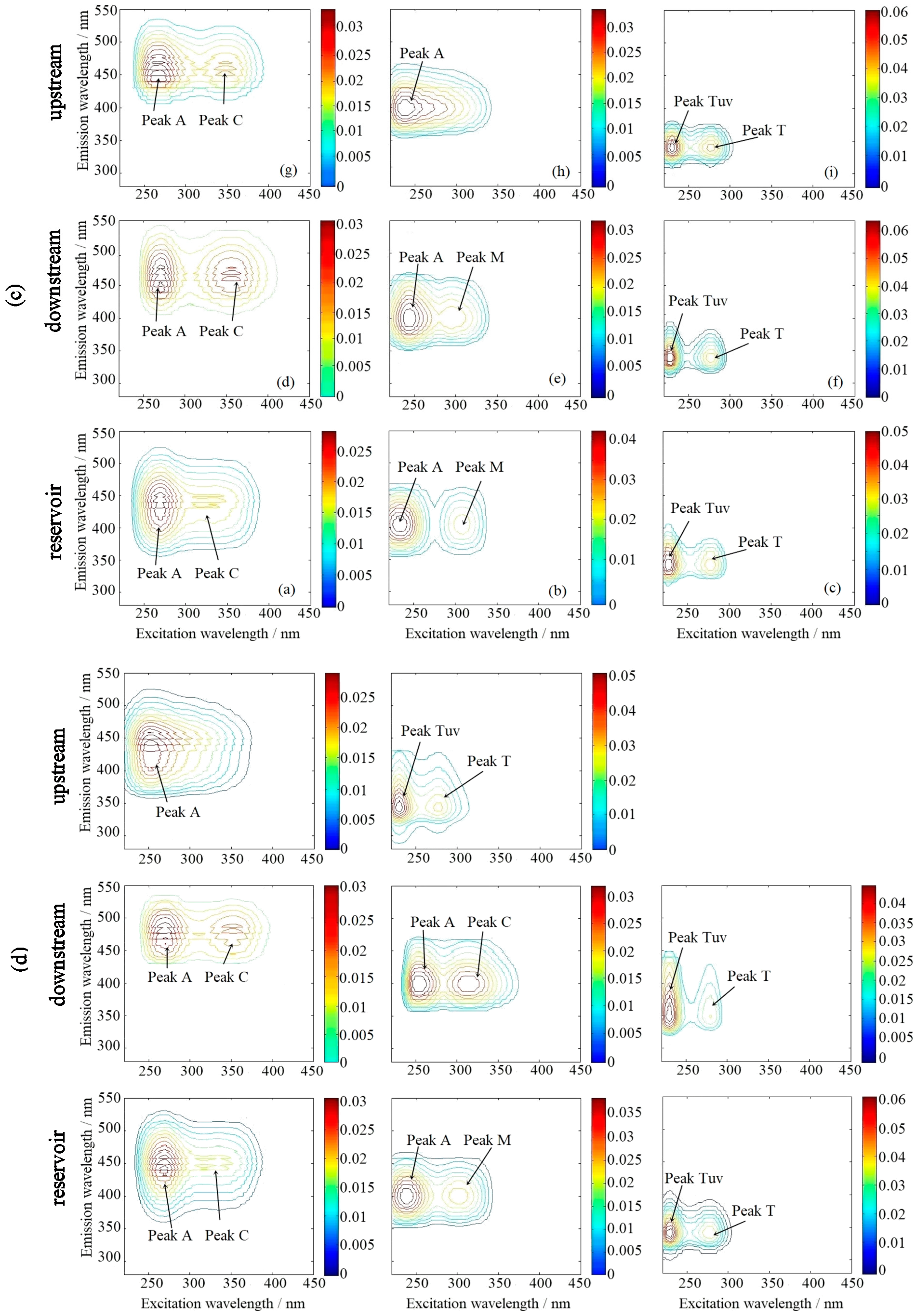
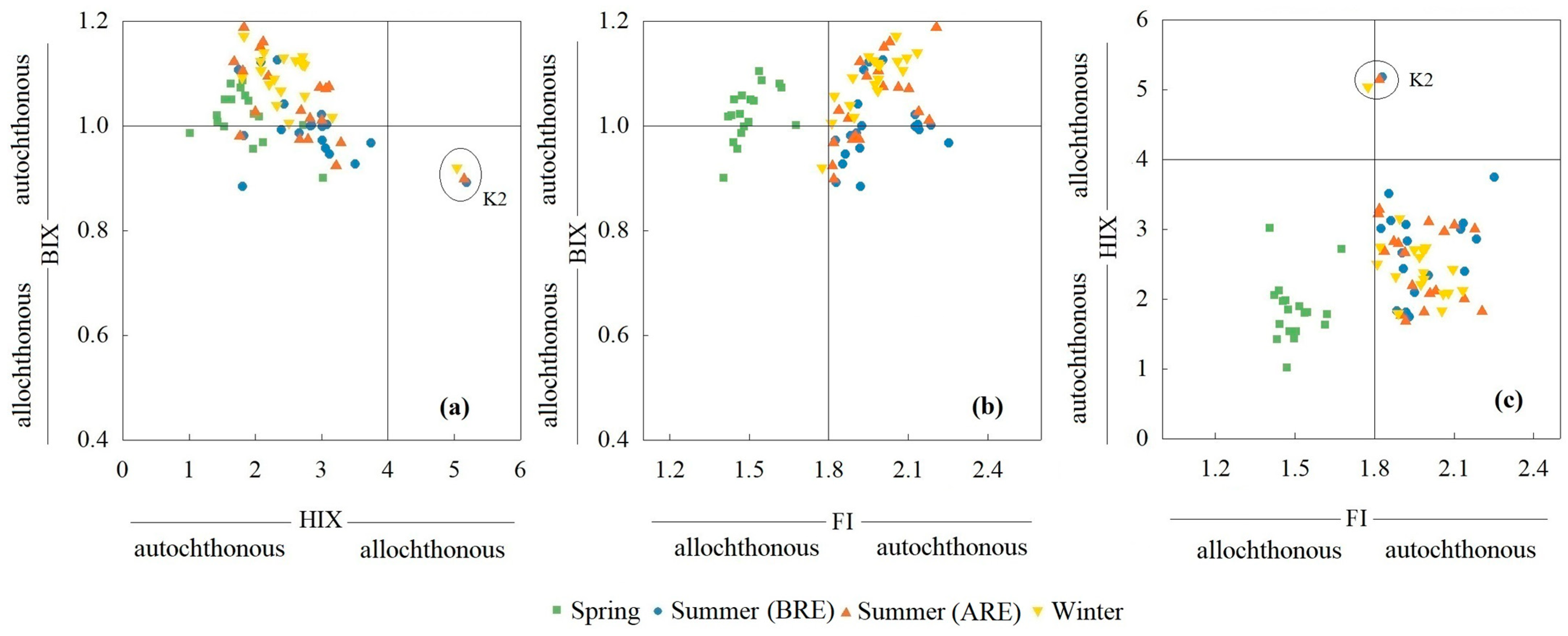

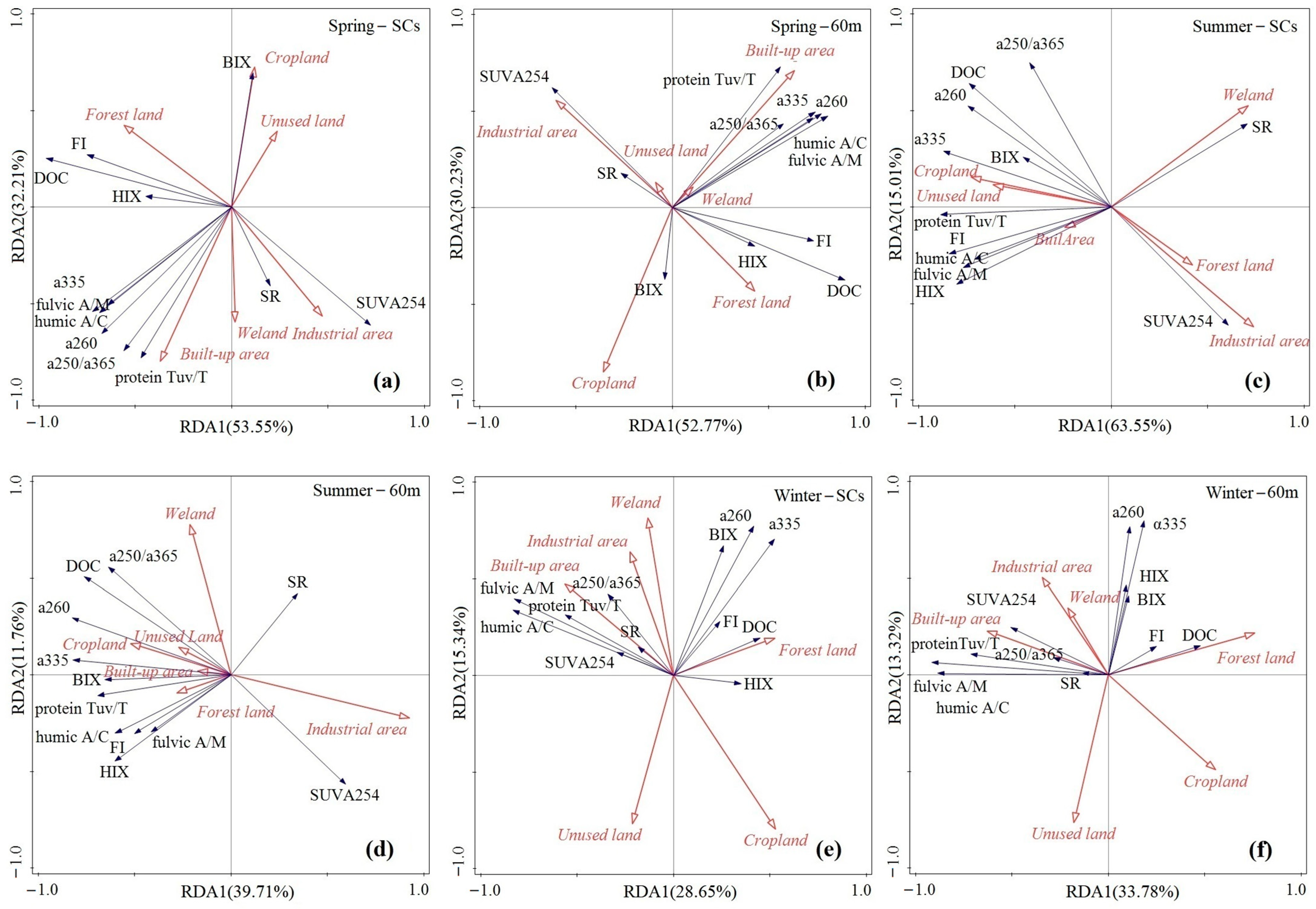

| Sampling Sites | Spring | Summer (BRE) | Summer (ARE) | Winter | ||||||||||||
|---|---|---|---|---|---|---|---|---|---|---|---|---|---|---|---|---|
| pH | EC ms·cm−1 | T °C | DO mg·L−1 | pH | EC ms·cm−1 | T °C | DO mg·L−1 | pH | EC ms·cm−1 | T °C | DO mg·L−1 | pH | EC ms·cm−1 | T °C | DO mg·L−1 | |
| Upstream (R7–R12) | 8.68 | 2.85 | 11.4 | 11.22 | 8.45 | 3.21 | 29.7 | 8.72 | 8.63 | 2.71 | 31.57 | 11.46 | 8.64 | 2.15 | 4.61 | 13.11 |
| Downstream (R1–R6) | 8.81 | 28.84 | 12.43 | 12.92 | 8.35 | 34.86 | 31.45 | 10.92 | 8.68 | 32.72 | 34.2 | 12.83 | 8.86 | 7.89 | 4.43 | 14.44 |
| Reservoir (T, K1–K6) | 8.69 | 5.05 | 12.92 | 11.11 | 8.29 | 4.65 | 30.6 | 7.22 | 8.54 | 4.70 | 34.4 | 9.73 | 8.41 | 4.56 | 4.93 | 11.53 |
| Parameter Values | DOC mg C·L−1 | a335 m−1 | a260 m−1 | a250/a365 | SR | SUVA254 L·(mg C)−1·m−1 | |
|---|---|---|---|---|---|---|---|
| Seasons | |||||||
| spring | Range | 0.73–11.6 | 11.1–25.68 | 23.6–82.3 | 3.37–5.42 | 1.48–2.59 | 4.72–46.8 |
| Mean ± Std | 5.78 ± 3.32 | 15.5 ± 3.72 | 43.5 ± 13.9 | 4.32 ± 0.60 | 1.79 ± 0.23 | 14.0 ± 12.6 | |
| summer (BRE) | Range | 4.93–19.2 | 11.6–30.6 | 27.1–110.1 | 3.68–6.34 | 1.38–2.13 | 3.15–12.6 |
| Mean ± Std | 12.9 ± 4.10 | 17.8 ± 3.57 | 53.3 ± 15.9 | 4.78 ± 0.58 | 1.66 ± 0.21 | 4.95 ± 2.11 | |
| summer (ARE) | Range | 5.27–21.2 | 14.3–30.4 | 34.6–106.2 | 3.44–5.93 | 1.46–2.18 | 2.12–7.15 |
| Mean ± Std | 14.9 ± 5.23 | 18.4 ± 3.49 | 53.3 ± 14.5 | 4.50 ± 0.57 | 1.70 ± 0.22 | 4.28 ± 1.46 | |
| winter | Range | 0.83–14.4 | 2.76–19.6 | 11.8–86.6 | 7.50–11.8 | 1.07–1.40 | 2.16–25.7 |
| Mean ± Std | 7.31 ± 4.02 | 7.48 ± 3.51 | 32.7 ± 15.6 | 8.60 ± 0.98 | 1.17 ± 0.08 | 7.48 ± 6.30 |
| Type | Humic-Like Peak Ex/Em(nm) | Fulvic-Like Peak Ex/Em(nm) | Protein-Like Peak Ex/Em(nm) | References |
|---|---|---|---|---|
| Coastal wetland and estuarine | <265/460; 350/470 | — | 280/325; 275/303 | [37] |
| Algal culturing | 255/455; 340/455 | — | 275/340 | [38] |
| Wastewater treatment plant | — | 245/425; 323/425 | 230, 275/345; 220/305, 345 | [39] |
| Lake water | 345/556; 495/556 | 320/420 | — | [40] |
| Vertical flow constructed wetland | — | 240~270/370~440; 310~360/370~450 | 220~230/320~350; 270~280/320~350 | [41] |
Publisher’s Note: MDPI stays neutral with regard to jurisdictional claims in published maps and institutional affiliations. |
© 2021 by the authors. Licensee MDPI, Basel, Switzerland. This article is an open access article distributed under the terms and conditions of the Creative Commons Attribution (CC BY) license (http://creativecommons.org/licenses/by/4.0/).
Share and Cite
Han, Z.; Xiao, M.; Yue, F.; Yi, Y.; Mostofa, K.M.G. Seasonal Variations of Dissolved Organic Matter by Fluorescent Analysis in a Typical River Catchment in Northern China. Water 2021, 13, 494. https://doi.org/10.3390/w13040494
Han Z, Xiao M, Yue F, Yi Y, Mostofa KMG. Seasonal Variations of Dissolved Organic Matter by Fluorescent Analysis in a Typical River Catchment in Northern China. Water. 2021; 13(4):494. https://doi.org/10.3390/w13040494
Chicago/Turabian StyleHan, Zenglei, Min Xiao, Fujun Yue, Yuanbi Yi, and K. M. G. Mostofa. 2021. "Seasonal Variations of Dissolved Organic Matter by Fluorescent Analysis in a Typical River Catchment in Northern China" Water 13, no. 4: 494. https://doi.org/10.3390/w13040494







